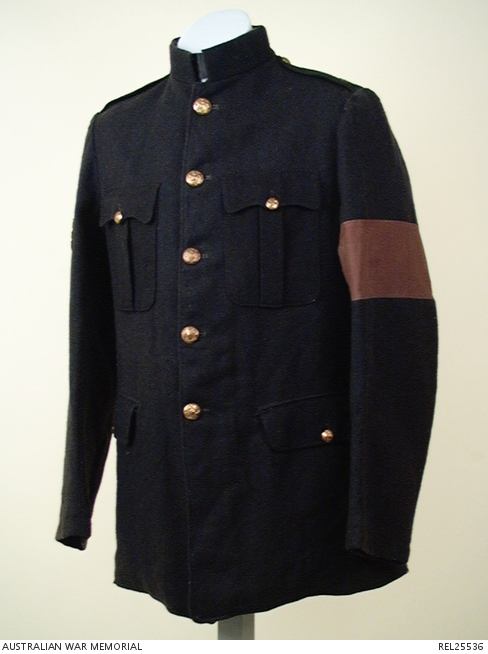| Places | |
|---|---|
| Accession Number | REL25536 |
| Collection type | Heraldry |
| Object type | Uniform |
| Physical description | Brass, Cotton drill, Wool serge, Wool twill |
| Maker |
Unknown |
| Place made | Germany |
| Date made | c 1915-1917 |
| Conflict |
First World War, 1914-1918 |
German issued jacket for POW : Sergeant H C Toon, 48 Battalion AIF

German issued black woollen serge jacket with stand collar as worn by Prisoners of War (POWs). A black leather tab has been sewn onto the inside of the opening at the front, on the left side. Paired holes in the front of the collar indicate that badges were once fitted to it. German Army silver metal numerals '4' and '8' are fitted to both of the epaulettes. An armband of brown cotton drill fabric, to indicate the wearer's prisoner of war status, has been incorporated into the upper left sleeve. The patch pockets on both breasts are pleated and the bottom edge of their flap is scalloped. A pocket with a buttoned flap has been let into both sides of the front of the jacket below the waistline. The buttons are standard British Army general service ones made from brass. A French Army sergeant's yellow cloth chevron has been sewn onto the upper right sleeve. The body of the jacket is lined with light brown coarse woollen fabric.
This jacket was worn by 155 Sergeant Herbert Choice Toon (he changed the spelling his name to Toone after the war) while he was a prisoner of war in Germany in 1917 and 1918. Sergeant Toon was born at Atherstone, England on 21 September 1888. For four and a half years he was ship's officer on board Arranmore, based at Maidenhead. Later he worked as a crewman on pearling luggers in Broome, Western Australia. Toon he enlisted at Perth, WA, on 9 September 1914. He embarked from Melbourne with C Company of 16 Battalion on 22 December 1914, aboard HMAT Ceramic. He was promoted to Sergeant in Egypt on 13 May 1915. He served on Gallipoli in 1915 but was evacuated on a number of occasions, and admitted to hospital in Egypt, for a variety of illnesses, including typhoid fever, influenza and enteritis. On 19 April 1916 he was transferred to the newly formed 48 Battalion. On 6 June 1916 he left Egypt for England, arriving at Plymouth on 16 June. Toon was captured by the Germans at Passchendaele on 12 October 1917. His battalion launched an attack on the enemy positions near Roulers at 5.25 am. Their objective was the village of Roulers, over 1 1/2 kilometers from their jumping off line. They advanced around 730 metres before they had to take cover in shell holes due to strong enemy fire power. During the German counter attacked Sergeant Toon's colleagues were killed and he was captured. He was sent behind the German lines to Inglemunster, where he was questioned, but gave no answer. He was later sent to Dulmen for fumigation and finally sent to Hameln 17, a prison camp for non commissioned officers (NCOs), arriving there on 20 November 1917. The camp held 900 NCOs, including 60 Australians when Sergeant Toon arrived. He volunteered to work in the Bureau on Prisoner's work at the Headquarters in Hameln Camp. After the armistice was signed on 11 November 1918, the prisoners were told on a number of occasions that they would be repatriated to England. When this failed to eventuate, Sergeant Toon decided to take matters into his own hands. He forged a pass which allowed him free train travel. On 12 December 1918, using the pass, he left Hameln and made his way through Germany to France by train. He then caught a ship to England and arrived there on 19 December. He left England to return to Australia on 12 April 1919. Toon was a member of 6 Battalion (City of Melbourne Regiment) between the wars and was selected to travel to England as a member of the Australian Coronation Contingent 1937 for the coronation of King George VI. During the Second World War he served again, with Brigade Headquarters and afterwards until 1947. The uniforms issued to Allied POWs in Germany during the First World War were in fact standard British Army khaki service dress tunics shipped to Germany by the Red Cross. They were then dyed black by the Germans and a brown armband was added. Some prisoners, like Toon, added numerals and rank insignia, which they had obtained from other prisoners.
Share this page
Related information
Conflicts
Events
Subjects
People
Related Objects
- 1914-15 Star : Sergeant H C Toon, 16 Battalion AIF
- British War Medal 1914-20 : Sergeant H C Toon, 16 Battalion, AIF
- Victory Medal : Sergeant H C Toon, 16 Battalion AIF
- George VI Coronation Medal : Sergeant H C Toone
- British War Medal 1939-45 : Sergeant H C Toone
- Australia Service Medal : Sergeant H C Toone
- Efficiency Medal and bar : Warrant Officer 2nd Class H C Toone
- Identity discs : Sergeant H C Toon 48 Battalion A.I.F.
- Identity bracelet : Sergeant H C Toon, 48 Battalion AIF
- Portrait of 155 Sergeant Herbert Choice Toon of the 16th and later 48th Battalion. He enlisted in ...